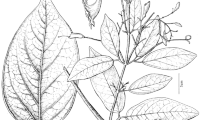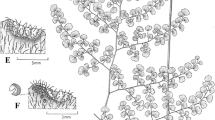Abstract
A new species of Scuticaria from the Colombian Amazon region, S. guainiana, is described and illustrated. The new species resembles S. steelei from which it differs in flower size and structure of the lip callus. The taxonomic affinities of the new species are briefly discussed.
Similar content being viewed by others
Avoid common mistakes on your manuscript.
The orchid genus Scuticaria was described by John Lindley in 1843 based on Neotropical species described by Hooker as Maxillaria steelei (Hooker 1837; Lindley 1843). The species was unique in Maxillaria Ruiz and Pav. in its pendent, long, terete leaves characterized by the presence of the longitudinal groove. While Lindley characterized the newly established genus as ebulbous, the inconspicuous, reduced, narrowly cylindrical pseudobulbs are present in all species of Scuticaria.
Despite the numerous discussions between taxonomists on the generic delimitation and composition of Maxillariinae, the position of Scuticaria within this subtribe was usually accepted (Pfitzer 1887; Dressler and Dodson 1960; Dressler 1981; Szlachetko 1995; Chase et al. 2003; Szlachetko and Mytnik-Ejsmont 2009). The position of the genus within Bifrenariinae was suggested by Dressler (1993) and the close relation of Scuticaria with Bifrenaria and Rudolfiella was indicated in the molecular research of Koehler et al. (2002) and Whitten et al. (2000).
Representatives of the genus grow as caespitose plants with creeping, short rhizome. Their indistinctive pseudobulbs are concealed with tubular, scarious bracts and their leaves can reach more than 150 cm long. The lateral inflorescence arises from the base of the pseudobulbs and it is composed of 1–3 resupinate, fleshy, large and showy flowers. The lateral sepals are adnate to the column foot forming a conspicuous mentum and the lip is articulate with the column foot. The lip lateral lobes are usually erect and the middle lobe is usually notched at the apex or divided into distinctive lobules. The lip callus is usually several-keeled, but it may have a form of a fleshy pad in some species. The slender, elongate gynostemium is gently arched, with the narrowly winged column part that is four times longer than anther. The column foot is prominent, stout, about half as long as the column part. The incumbent, operculate anther is ellipsoid–ovoid, two-chambered. The two pairs of pollinia are superposed, unequal in size, dorsiventrally compressed, delicate, rather soft. The apical clinandrium forms rather high, collar-like structure. The relatively small stigma is elliptic, deeply concave. The rostellum is dome-like and its remnant is rather shallowly notched or shortly triangular. The single viscidium is narrow, rather fleshy and sticky, selliform and the single tegula is transversely elliptic-triangular, thin, lamellate, Rostellum remnant (Whitten 2009; Szlachetko and Mytnik-Ejsmont 2009).
The genus consists of about ten species distributed from Colombia and Venezuela to Brazil and Guianas between the altitudes of 100 and 1,500 m. The occurrence of Scuticaria representatives was reported from various habitats—from lowland rain forests and savannas to the montane and elfin forests. The plants may grow as epiphytes in mosses mats or lithophytes on gneiss (Carnevali and Ramirez-Morillo 2003; Whitten 2009).
So far a single species of Scuticaria, S. steelei (Hook.) Lindl. was reported from Colombia (Ortiz Valdivieso and Uribe Vélez 2007), where it is restricted to the lowland areas. The recent studies on national Orchidaceae revealed the existence of distinctive Scuticaria species in the Colombian Amazon region which is described here as new.
Materials and methods
Dried herbarium specimens were examined according to the standard procedures. Each studied sheet was photographed and the data from the labels were taken. Both vegetative and generative characters of every plant were studied. The presence, shape and size of the pseudobulbs and leaves arrangement were examined first. Then the construction of the inflorescence and the shape and size of the floral bracts were studied. The morphology of flower, including gynostemium, was examined after it is softened in the boiling water. At the end of the measurements, the surface of each floral element was studied under a stereomicroscope.
Acronyms for herbaria cited in this paper followed Index Herbariorum (Thiers, continuously updated). The CorelDraw v.12 software was used for the preparation of the distribution map.
Taxonomic treatment
Scuticaria guainiana Kolan. and Szlach., sp. nov. (Fig. 1)
Species similar to Scuticaria steelei (Hook.) Lindl., distinguished from it by the smaller flowers and 3-lobed, hairy lip callus.
Type
Betancur and González 13389-Colombia, Guainía, Mpio. Inírida, márgen izquierda del río Inírida, entre las comunidades Zancudo y Guacamayas. Bosque de tierra firme y sabana abierta y arbolada, 2°44′–2°45′N, 69°24′–69°25′W, Transecto F (11 Aug 2008), (COL! holotype).
Plant pendent, caespitose. Pseudobulbs inconspicous, up to about 2.5 cm long, cylindric, unifoliate. Leaf over 60 cm long, coriaceous, terete. Inflorescence short, 2-flowered. Flowers yellow with irregular maroon spots. Pedicel 20 mm long, ovary 10 mm long. Floral bract 3 mm long. Dorsal sepal 30 mm long, 13 mm wide oblong-elliptic, apiculate. Petals 26 mm long, 9 mm wide, falcate, oblong-elliptic, apiculate. Lateral sepals 25 mm long, 16 mm wide, falcate, oval, apiculate. Lip 3-lobed, margins somewhat undulate; lateral lobes 15 mm long, 25 mm wide, ovate, rounded; middle lobe bilobulate, lobules 15 mm long, 12 mm wide, suborbicular, apical part thick; disc with numerous thickened veins diverging apically, callus prominent, about 10 mm long, hairy, 3-lobulate above the middle, lateral lobes ovate, middle lobe shorter, linear. Gynostemium 20 mm long, column foot 10 mm long, pubescent (Figs. 1, 2).
Distribution, habitat and ecology. Known from the Colombian Amazon region where it was found growing epiphytically in forested savanna at about 120 m of elevation. Flowering in July and August.
Etymology
In reference to the Colombian Department of Guainia, where the type specimen was collected.
Representative material
J. Betancur and J. Gonzalez 13389-Colombia, Guainia, Mpio. Inirida. Margen izquierda del Rio Inirida, entre las comunidades Zancudo y Guacamayas. Bosque de tierra firme y sabana abierta y arbolada, 2°44′–45′N 69°24′–25′W, Alt. 120 m (11 Aug 2008), (COL!); Schultes and I. Cabrera 13103-Colombia, Vaupés, Rio Kananari. Cachivera Palito (25 Jul 1951), (COL!).
Taxonomic notes
The hairy, 3-lobulate callus observed in S. guainiana is unique in the genus. The soft hairs are also observed on the lip of S. hadwenii (Lindl.) Hoehne known from Guyana and Brazil, however in this species the callus has a form of a fleshy, concave pad which is tridentate and elevated at the apex. The callus of the only Colombian representative of Scuticaria, S. steelei (Hook.) Lindl., consists of 3–5, glabrous ridges. From S. salesiana Dressler and S. peruviana D.E. Benn. and Christenson, known from Ecuador and Peru, the new species is easily distinguishable by the small middle lobe (vs. middle lobe larger than lateral lobes in S. salesiana and S. peruviana). Unlike S. guainiana, the middle lobe of S. novaesii F. Barros and Cath. is entire and in other Brazillian species, S. irwiniana Pabst and S. kautskyi Pabst only shortly bifid. The callus of S. itirapinensis Pabst consists of four glabrous ridges while in S. bahiensis it has a form of a fleshy, concave pad dentate apically.
Additional information
According to the information on the herbarium label the common name of the species in the Puinave language is “cop”. The type specimen was previously identified as S. steelei. Possibly the flower was not boiled during the earlier studies hereby the callus structure can not be observable in details. This character is well-visible in the softened flowers, even if they were pressed during specimen’s mounting.
References
Carnevali G, Ramirez-Morillo I (2003) Scuticaria. In: Steyermark JA, Berry PE, Yatskievich K, Holst BK (eds) Flora of the Venezuelan Guyana 7. Missouri Botanical Garden Press, St. Louis, p 564
Chase MW, Barret RL, Cameron KN, Freudenstein JV (2003) DNA data and Orchidaceae systematics: a new phylogenetic classification. In: Dixon KM (ed) Orchid conservation. Natural History Publications, Kota Kinabalu, pp 69–89
Dressler RL (1981) The orchids: natural history and classification. Harvard University Press, Cambridge
Dressler RL (1993) Phylogeny and classification of the orchid family. Cambridge University Press, Cambridge
Dressler RL, Dodson CH (1960) Classification and phylogeny in the Orchidaceae. Ann Miss Bot Gard 47:25–68
Hooker WJ (1837) Maxillaria steelei. Bot Mag 64:3573
Koehler S, Williams NH, Whitten WM, Amaral MCE (2002) Phylogeny of the Bifrenaria (Orchidaceae) complex based on morphology and sequence data from nuclear rDNA internal transcribed spaces (ITS) and chloroplast trnL-trnF region. Int J Plant Sci 163:1055–1066
Lindley J (1843) Maxillaria. Bot Reg 29:10–16
Ortiz Valdivieso P, Uribe Vélez C (2007) Galería de Orquídeas de Colombia (CD edition). Asociación Bogotana de Orquideología, Bogotá
Pfitzer EH (1887) Entwurf einer natuerlichen Anordnung der Orchideen. Wilhelm Hofmeister, Carl Winter, Heidelberg
Szlachetko DL (1995) Systema Orchidalium. Fragm Flor Geobot Suppl 3:1–137
Szlachetko DL, Mytnik-Ejsmont J (2009) Gynostemia Orchidalium IV. Acta Bot Fenn 180:1–313
Whitten WM (2009) Scuticaria. In: Pridgeon AM, Cribb P, Chase MW, Rasmussen FN (eds) Genera Orchidacearum, vol 5., Epidendroideae (Part 2): EpidendroideaeOxford University Press, Oxford, pp 200–202
Whitten WM, Williams NH, Chase MW (2000) Subtribal and generic relationships of Maxillarieae (Orchidaceae) with emphasis on Stanhopeinae: combined molecular evidence. Am J Bot 87:1842–1856
Thiers B (continuously updated) Index Herbariorum. A global directory of public herbaria and associated staff. New York Botanical Garden’s Virtual Herbarium. http://sweetgum.nybg.org/ih/
Acknowledgments
The Curator and staff of the National Colombian Herbarium are thanked for their kind hospitality and assistance during visits and for making specimens available on loan. The research described here has been supported by the Polish Ministry of Science and Higher Education (Research Grant No. 8124/B/PO1/2011/40).
Author information
Authors and Affiliations
Corresponding author
Rights and permissions
Open Access This article is distributed under the terms of the Creative Commons Attribution License which permits any use, distribution, and reproduction in any medium, provided the original author(s) and the source are credited.
About this article
Cite this article
Kolanowska, M., Szlachetko, D.L. A new species of Scuticaria (Maxillariinae) from Colombia. Plant Syst Evol 300, 1047–1050 (2014). https://doi.org/10.1007/s00606-013-0943-2
Received:
Accepted:
Published:
Issue Date:
DOI: https://doi.org/10.1007/s00606-013-0943-2






